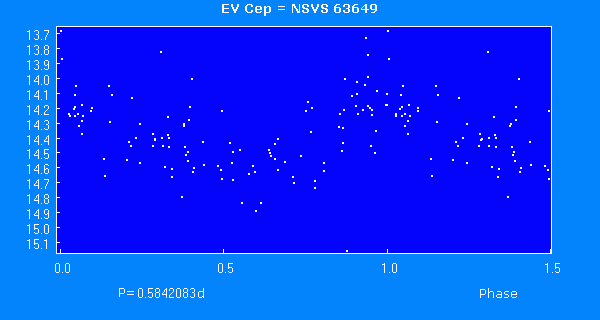"Peremennye Zvezdy",
Prilozhenie,
vol. 10, N 20 (2010)
Prilozhenie,
vol. 10, N 20 (2010)
New Evidence in the Case of the Lost Variables EV and EW Cep
D. Denisenko
Space Research Institute (IKI), Russian Academy of Sciences, Moscow, Russia
Draft in Preparation; accepted: 25.05.2010
(E-mail for contact: denis@hea.iki.rssi.ru)
| ||||||||||||||||||||||
Remarks: |
| I report the identification of two long-lost variable stars, EV Cep and
EW Cep. They were discovered by Hoffmeister (1964) from
Sonneberg plates as S 8283 and S 8284, respectively. The following
coordinates (equinox 1855.0) and magnitude ranges were reported in the
discovery paper on page 54:
S 8283 Cep | 1h 22m.1, +84o 20' | 14-15 | short period (probably RR Lyrae); S 8284 Cep | 1h 31m.2, +83o 58' | 17-18 | RR Lyrae. These coordinates were precessed to equinox B1950.0 (and later to J2000.0) and included into all releases of the General Catalogue of Variable Stars (GCVS) (Samus et al. 2007-2009) as follows: EV Cep: 013523. +844900* (014314. +850409*); EW Cep: 014443. +842700* (015238. +844151*). An asterisk after the coordinates in the GCVS means rough coordinates, usually with a variable's declination accurate to about one arcminute. However, no star patterns resembling Hoffmeister's finding charts were found for these stars by Skiff (1999) who had successfully identified all the other stars from Hoffmeister (1964). Subsequent attempts to identify these two stars have also failed. A visual inspection by the author has shown no matches in 15'x15' DSS images for both stars. Then, the fact that two stars in a sequence were missing immediately suggests an idea that their coordinates could be wrong. For instance, Hoffmeister could have unintentionally swapped the right ascensions (or declinations) of the two stars. Checking the corresponding positions has immediately shown that the hypothesis of swapped declinations is indeed correct. Both stars were found within an arcminute from the trial coordinates. The star patterns on Palomar DSS plates have perfectly matched those on page 64 in the discovery paper, shown as inserts on the finding charts. The catalogue magnitudes of both stars have also match the data in Hoffmeister (1964). Below I present the corrected coordinates of EV Cep and EW Cep with their magnitudes from the USNO-B1.0 and 2MASS catalogues. EV Cep = S 8283: USNO-B1.0 1747-0004061: 01 43 17.33, +84 43 53.65 (J2000); B1 = 14.64, R1 = 13.83, B2 = 14.91, R2 = 13.94, I = 12.49. 2MASS 01431743+8443536: 01 43 17.435, +84 43 53.70 (J2000); J = 12.803+/-0.026, H = 12.497+/-0.029, K = 12.406+/-0.033. EW Cep = S 8284: USNO-B1.0 1750-0004880: 01 53 30.68, +85 03 44.95 (J2000); B1 = 17.75, R1 = 16.03, B2 = 17.16, R2 = 16.10, I = 15.67. 2MASS 01533071+8503448: 01 53 30.714, +85 03 44.83 (J2000); J = 14.917+/-0.046, H = 14.577+/-0.064, K = 14.512+/-0.088. The J-K color indices about 0.4 agree well with the RR Lyr classification by Hoffmeister. Moreover, the brighter of the two stars, EV Cep, was identified with NSVS 63649 (Wozniak et al. 2004) observed from JD 2451282 to 2451619 by the ROTSE-I project, allowing us to plot its light curve and to determine the period of its variations. The corresponding light curve folded with a period of 0.58421d is shown in the Figure. The other star, EW Cep, is too faint to be detected by ROTSE-I. Thus, its real magnitude range and period remain unknown. Acknowledgements: I thank I.M. Sergei and I.S. Bryukhanov for pointing my attention to this star. |
| References: |
| Hoffmeister, C., 1964, Astron. Nachrichten, 288, 49
Samus, N.N., Durlevich, O.V., et al., 2007-2009, General Catalogue of Variable Stars, 2009yCat....102025S Skiff, B.A., 1999, IBVS, No. 4721 Wozniak, P.R., Vestrand, W.T., Akerlof, C.W., et al., 2004, Astron. J., 127, 2436 |
Light Curve
The light curve of EV Cep = NSVS 63649 folded with P = 0.58421d. Finding Chart 
a: A 5'x5' DSS finding chart for EV Cep, with the chart for S 8283 Cep from Hoffmeister (1964) inserted; b: same for EW Cep and S 8284 Cep (insert). |